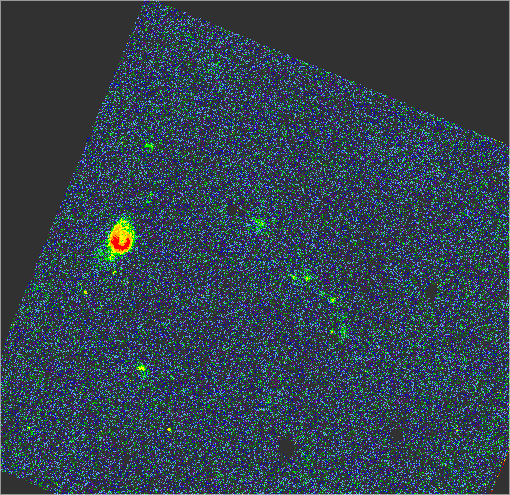Supernovae and supernova remnants
Supernovae
|
Generally accepted scheme distinguishes two main classes of
supernovae (SNe): Ia resulting from the old stellar population
(thermonuclear explosion of a white dwarf, or a merger of two white dwarfs in a close binary system), and SNe
of type II and Ib/c whose ancestors are young massive stars (died
in a core-collapse explosion). Historically, classification of SNe, according to their optical
spectra, began by recognizing SNe I, with no hydrogen lines, and
SNe II which do show hydrogen in their spectra. In addition, SNe
II were shown to exhibit much wider photometric behavior than SNe
I, which seemed to be a rather homogeneous class of objects.
Nevertheless, it was shown later that there are actually two
spectroscopically and photometrically distinct subclasses of SNe
I: Ia located only in ellipticals, and Ib found in HII
regions and spiral arms, which strongly suggested that their
progenitors were massive young stars with their hydrogen envelopes
stripped. The third subclass, SNe Ic, discovered later, show no
helium lines either, and thus correspond to massive stars
stripped of their H and He envelopes.
|
Compact objects
Core-collapse supernovae, as their name suggests, are following the formation of
compact stellar remnants: neutron stars and black holes.
|
|

Classification of supernovae. |
Pair production supernovae Pair production supernovae are presumed to be the final stage of the evolution of very massive stars, M > 100 solar masses, in whose cores the temperature is so high that electron-positron pairs are created from high energy γ- ray photons. The explosion is believed to disrupt the whole star (no compact stellar remnant) and is presumed to occur primarily in Population III stars. |
|
|
SN Ia are known in astronomy as the "standard candles". Better understanding of some type II events (e.g. SNe II-P) and stripped-envelope SNe (Ib/c) could lead to their potential use as distance indicators as well. The problem of extinction is the most important issue to be dealt with in the process of obtaining true SN luminosities (absolute magnitudes). The plane-parallel model which gives absorption dependent on galaxy inclination (A ~ sec i), widely used in the past, was shown not to describe extinction adequately. There is some hope in an alternative model which introduces radial dependence of extinction, but further investigation is necessary. |
||
Selected papers
Supernova remnants
|
While supernova events happen quite suddenly and last for a relatively short time, in astronomical
standards, supernova remnants (SNRs) - the material ejected in explosion continues its life through the interaction with the surrounding interstellar medium (ISM) for thousands, and in extreme cases even for a million years. The standard picture of hydrodinamic evolution of supernova remnants, from supernova to the end of expansion, assumes four different phases: 1) free expansion, 2) adiabatic i.e. Sedov's phase, 3) isothermal or radiative phase, and 4) dissipation. During the first phase ejected material expands with constant velocity v2 = (dR/dt)2 ~ Eo/Mo, where R and t are radius of SNR and time since the explosion, respectively, Eo is SN energy and Mo is the mass of the ejecta. The term 'free expansion' for the first phase of evolution of SNRs is more historical, since there may be significant declaration even in this phase. When the shock wave sweeps-up enough ISM so that its mass exceeds many times the mass of SN ejecta, a SNR enters the second phase of evolution. |
||
|
During this phase the shock wave decelerates according to the law
v = dR/dt = 2R/(5t), i.e.
R = 1.17 (Eo/ρo)1/5t2/5,
which is the well known Sedov's solution for a
point-like explosion in uniform medium with density ρo.
When the temperature behind the shock drops the energy loses due
to radiation become significant and a remnant enters
the radiative phase of evolution. It
is expected in this epoch that SNR undergos a phase of dense shell
formation. The remnant continues to expand as pressure-driven,
(R ~ t2/7) or momentum-conserving snowplow (R ~ t1/4).
Finally, when the expansion velocity becomes comparable with the
sound speed in the surroundings, v2 ~ cs2 = γpo/ρo, supernova remnant will merge with the interstellar
medium and the evolution ends.
|
||
|
An interesting issue concerning SNRs is the question of their radio evolution
or the so called Σ–D (surface brightness to diameter) relation
which can be written in the form Σ = A D-β.
Since parameters of the explosion (Eo, Mo) and the expansion (ρo) may substantially
differ from remnant to remnant, it has been generally accepted that no single Σ–D relation
can be constructed for all SNRs. However, it still might be possible
to construct the relations for some classes of SNRs. This would be
of great practical importance for estimation of distances to SNRs
when no other methods are available.
|
 Hα image of HII regions and a possible hypernova remnant in Holmberg IX in M81 galaxy group, obtained with 2m RCC telescope at NAO Rozhen, Bulgaria. |
|
Selected papers




